 |
 |
 |
| |
PROVE2: phase II study of telapravir (VX-950) in combination with peginterferon alfa-2 with or without ribavirin in subjects with chronic hepatitis C, an interim analysis
|
| |
| |
Reported by Jules Levin
AASLD, Nov 2-6, 2007 Boston, MA
Christophe Hezode, Peter ferenci, Geoffrey Dusheiko, Stanislas Pol, Tobias Goeser, Jean-Pierre Bronowicki, Shahinb Gharakhanian, Desiree Devonish, Robert Kauffman, John Alam, Jean-Michel Pawltsky, Stefan Zuezum, & the PROVE2 Study Teams in France, Germany, Austria, UK, USA
AUTHOR SUMMARY
Study ongoing, with further interim analyses planned in 2008. Ongoing dialogue and coordination with Regulatory Authorities for next steps.
Skin and gastrointestinal adverse events occurred more commonly in the TVR groups.
Other adverse events were those that are expected with Peg-IFN+RBV.
No clinically relevant lab abnormalities aside from greater TVR-related decline in hemoglobin.
Singificantly higher proportion of TVR-treated patients achieved undetectable HCV RNA at weeks 4 and 12 compared to standard treatment.
Ribavirinb contributes to anti-viral activity of regimen
65% SVR (SVR12) rate achieved in 24 week treatment arm
--59% in 12 week treatment arm (SVR24); relapse rate higher
--concordance demonstrated between SVR 12 and 24
Low relapse rates in patients who achieve SVR
AUTHOR CONCLUSIONS
Combination treatment including a targeted HCV NS3-4A protease inhibitor (telaprevir) has the potential to increase SVR rates above current treatment.
Lower relapse rates in patients with RVR induced by specifically targeted treatments supports a viral dynamics-driven approach to achieving SVR in chronic hepatitis C.
PROVE2
Background & Rationale
Telaprevir (TVR), a selective inhibitor of HCV NS3-4A protease
Early phase clinical studies demonstrated consistent, rapid suppression of plasma HCV-RNA
PROVE 1 and 2 studies are designed to evaluate:
--whether consistent, rapid HCV RNA decline may translate into higher ratyes of SVR
--whether rapid viral inhibition induced by TVR in combination with Pef-IFN/RBV can lead to shortened overall treatment duration
--safety profile of up to 3 months TVR-combination dosing
ENTRY CRITERIA, DRUG REGIMEN
Randomized, placebo-controlled phase 2 study
323 treatment-naive patients with chronic genotype 1 HCV infection
standard entry criteria as for Peg-IFN/RBV studies, except for exclusion of cirrhosis (F4 or equivalent)
Study drug regimen:
--telaprevir (TVR) 750 mg or placebo every 8 hrs (day 1: first TVR loading dose of 1250mg)
--Peginterferon alfa-2a 180ug SC weekly
--ribavirin 1000/1200 mg daily
STUDY DESIGN
4 arms, one without RBV:
--control arm: placebo+Peg-IFN + RBV
--24 week arm: telaprevir + Peg-IFN + RBV for 12 weeks then Peg-IFN/RBv for 12 weeks.
--12 week arm: telaprevir + Peg-IFN + RBV
--No RBV arm: telaprevir + Peg-IFN
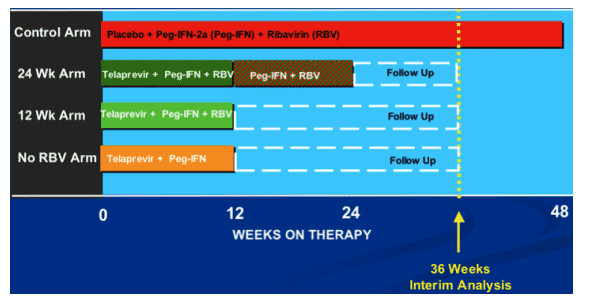
STUDY METHODS
Intent-to-treat analysis including all randomized patients who received at least 1 dose of study drug
Efficacy evaluation by Roche Taqman HCV RNA assay (LOD < 10 IU/mL)
Viral sequencing examination:
--nested sequencing amplification
--LOD for the sequencing assay, 1000 IU/mL (Poster LB8, tues Nov 6, 10-11:30 am.)
BASELINE CHARACTERISTICS
93-99% Caicasian.
--Median 45 yrs old (range 18-64)
--Median Weight 68-73 kg (range: 46-115)
--HCV subtype 1a: 40-51%; HCV 1b subtype: 49-60%
--Metavir (score %) F2F3- 28% Control arm; 35% 24 week arm; 35% 12 week arm; 26% no RBV arm.
--HCV RNA (log iu/mL, median: 6.4 in control arm; 6.6 in 24 week arm; 6.5 in 12 week arm; 6.4 in no RBV arm.
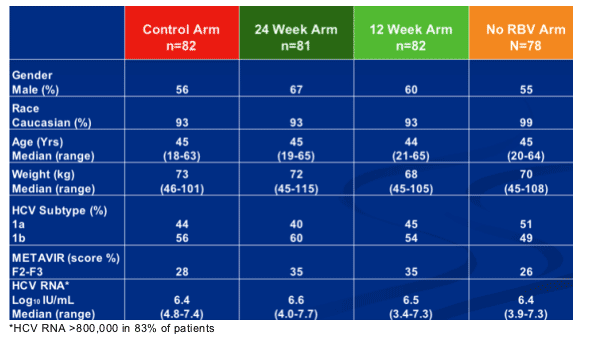
PATIENT DISPOSITION
Discontinued treatment prior to week 12:
4 (5%) in control arm
12 (15%) in 24 week arm (triple drug arm)
11 (13%) in 12 week arm (triple drug arm)
8 (10%) in no RBV arm
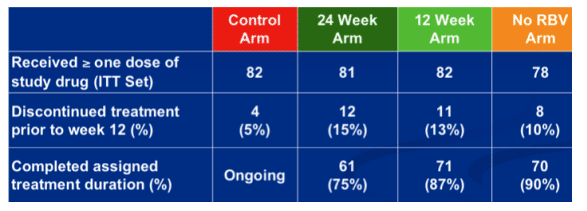
Main categories for discontinuastions in TVR groups during the first 12 weeks:
--adverse events: 23 patients (10%)
--consent withdrawal: 5 patients: (2%)
--non compliance: 3 patients (1%)
ADVERSE EVENTS During Initial 12 Weeks
Rash (all types): ALL EVENTS-- 26% in control arm (n=81); 47% in 12/24 week arms (n=163); 40% in no RBV arm. Grade 3 Events: none in control arm. 6% in 12/24 week arms; 4% in no RBV arm. Nausea (All Events): 32% in control arm; 48% in 12/24 week arms; 28% in no RBV arm.
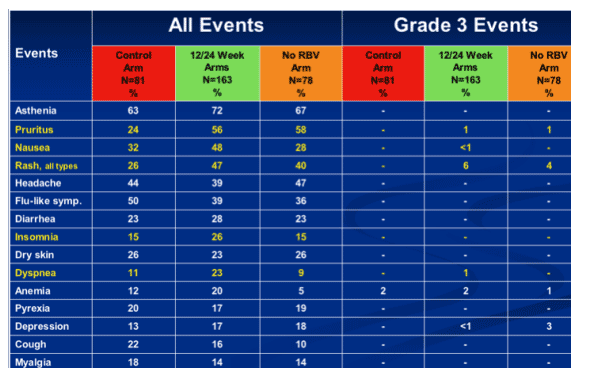
RASH CHARACTERISTICS
- Maculo-papular rash typical of drug reaction
- Resolved upon discontinuation of treatment
In this graph there is a 7% rash rate of discontinuation at week 12 in the 12/24 wk arms (n=163). The rate is 0 in control arm. And the rate is 3% in the no RBV arm.
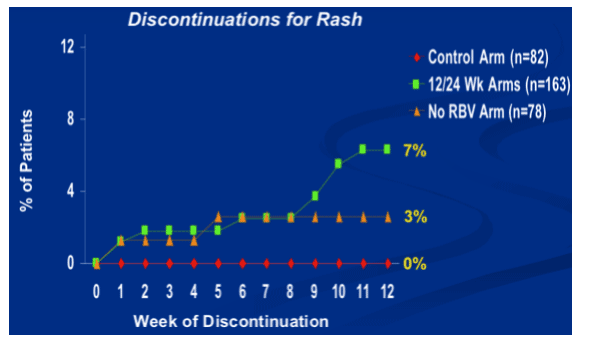
Hematologic Parameters
No effect of TVR on neutrophil or platelet counts
Increased hemoglobin reductions in 12/24 TVR arms:
35% grade 1 in 12/24 Wk arms, 29% in control arm, 19% in no RBV arm.
Grade 2: 18% in 12/24 Wk arms; 2% in control arm, 5% in no RBV arm.
Grade 3-4: 2% in 12/24 Wk arms, 1% in no RBV arm, 0 in control.
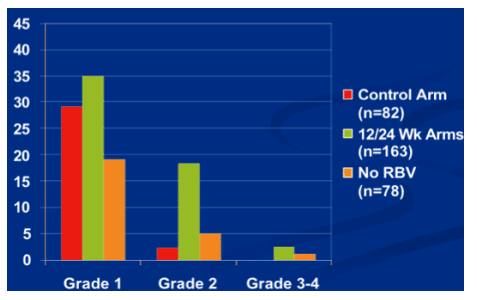
UNDETECTABLE HCV RNA at Weeks 4 and 12 (ITT)
Week 4:
80% in 12 week arm (n=82)*
69% in 24 week arm (n=81)*
13% in control arm*
51% in no RBV arm*
week 12
79% in 12 week arm*
73% in 24 week arm*
41% in control arm*
62% in no RBV arm*.
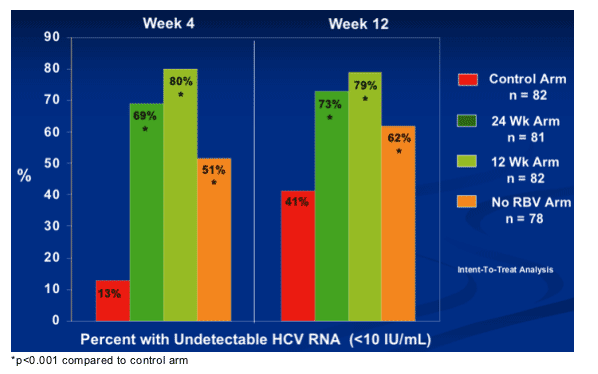
VIRAL BREAKTHROUGH
Viral breakthrough(increase in HCV RNA on treatment):
--increase of >1-lig above HCV RNA nadir
--increase to 100 IU/mL in previously undetectable patients
Breakthrough rate was 1% in control arm, 2% in 12+24 Wk arms, and 24% in no RBV arm.
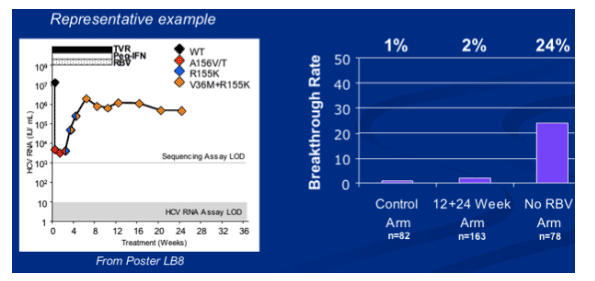
SVR RATES (ITT)
SVR12 (week 12 SVR): 65% in 24 week arm.
SVR24 (week 24 SVR)*: 59% in 12 week arm
SVR24** (no RBV arm)**: 29%
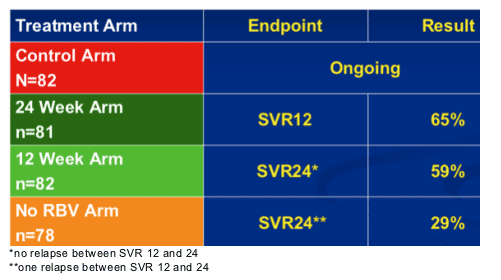
Relapse Rates in Patients Completing 12 and 24 Week arms
12 week arm Total Relapse 28% (18/63): No RVR 75% (6/8), RVR 22% (12/55).
24 Week arm Total Relapse 14% (8/57): No RVR 30% (3/10), RVR 11% (5/47)
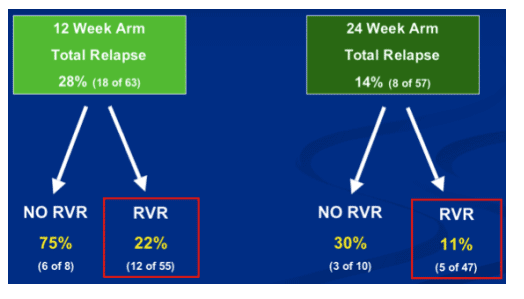
|
| |
|
 |
 |
|
|